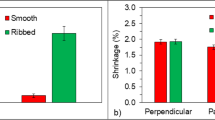Abstract
The author considers specifics of the method of quasi-isostatic molding, which is the most perfect, economical, and simple method for molding products from powder materials providing for a high quality of products due to the volume compression of the molding material. The method can be used for molding articles from ceramic, metal, and graphite powders, glass ceramics, ferrite, abrasive materials, and in production of refractory articles.
Similar content being viewed by others
REFERENCES
M. I. Timokhova, A study of Certain Factors of Hydrostatic Molding of Electroceramic Articles, Author's Abstract of Candidate's Thesis [in Russian], Moscow (1964).
M. I. Timokhova, Yu. N. Sil'vestrov, and Yu. G. Zorin, “Isostatic molding of ceramic articles,” Eletron. Tekh., Mater., Issue 3 (1972).
M. A. Rifai, A study of the Conditions of Isostatic Molding of Powders in Elastic Shells, Author's Abstract of Candidate's Thesis [in Russian], Moscow (1967).
A. M. Umanskii, A Study of the Conditions of Isostatic Molding of Powers in Elastic Shells, Author's Abstract of Candidate's Thesis [in Russian], Moscow (1971).
M. I. Timokhova, “Certain types of defects in technology of molding ceramic articles,” VNIIÉMS, Series 5, Issue 1 (1989).
K. N. Bogoyavlenskii, G. S. Batkov, P. A. Kuznetsov, et al., Molding Articles from Powder Materials Using Liquid and Elastic Media [in Russian], Leningrad (1983).
Urethane Elastomers [in Russian], Khimiya, Leningrad (1971).
M. I. Timokhova and Yu. N. Sil'vestrov, “Quasi-isostatic molding of ceramic articles,” in: Proceedings of All-Union Sci. Conf. ”C;Improvement of technology of electrical engineering porcelain production” [in Russian], Moscow (1978).
R. V. Dzerzhinskii, M. I. Timokhova, and V. S. Rachkov, Quasi-isostatic molding of ceramic articles,” in: Proceeding of Int. Conf., Bratislava [in Russian] (1987).
N. S. Kostyukov and M. I. Timokhova, “Isostatic molding of articles without an isostat,” Steklo Keram., No. 2 (1981).
R. Ya. Popil'skii and Yu. B. Pivinskii, Compression of Ceramic Powder Mixtures [in Russian], Metallurgiya, Moscow (1983).
N. E. Drozdov, Machinery at Ceramic Factories [in Russian], Mashinostroenie, Moscow (1975).
Rights and permissions
About this article
Cite this article
Timokhova, M.I. Certain Specifics of Quasi-Isostatic Molding (A Review). Glass and Ceramics 59, 22–26 (2002). https://doi.org/10.1023/A:1015519226476
Issue Date:
DOI: https://doi.org/10.1023/A:1015519226476




